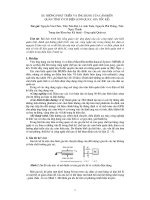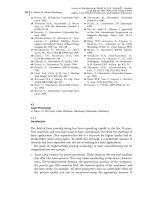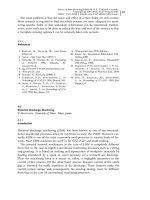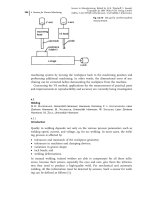Level measurement Cảm biến mức
Bạn đang xem bản rút gọn của tài liệu. Xem và tải ngay bản đầy đủ của tài liệu tại đây (3.59 MB, 73 trang )
Products
Solutions
Level Measurement
Slide 1 / 85
13 October 2015
GBO
Services
Level
Learning objectives
The participant knows…
•
•
•
•
… the different applications for level measurement
…the different technologies for level measurement
…which technologies are being used for the training rig
…the
h characteristics
h
i i off the
h used technologies
h l i
The participant understand…
• … each measurement technology has strength and weaknesses
• …application and process conditions are very important
Slide 2 / 85
13 October 2015
GBO
Level
Applications with Level Device
Level measurement applications in liquids including liquefied gases and
bulk solids are divided into four areas:
•
•
•
•
Continuous Measurement
Point Level Detection
D
Density
it
Interface measurement.
Slide 3 / 85
13 October 2015
GBO
Level
Applications with Level Device
The overview contains the measuring principles suitable for each area.
Slide 4 / 85
13 October 2015
GBO
Level
Finding the solution
• The first step in finding a solution for a level metering point is
finding
g the best suitable measuring
g technology
gy
• The selection is based on the requirements of the measuring
point e.g.:
Slide 5 / 85
13 October 2015
GBO
Level
Influences on the selection of the measuring system
Following can have an influence on the device selection
•
•
•
•
•
•
Instrument accuracy
Measuring range
Application limits
Process temperature
Process pressure
Process connection
Slide 6 / 85
13 October 2015
GBO
Level
Influences on the selection of the measuring system
Slide 7 / 85
13 October 2015
GBO
Level
Influences on the selection of the measuring system
Slide 8 / 85
13 October 2015
GBO
Level
Training Rig Level Measurement Technologies
• Vibrating level detection
• Capacitive level detection
• Microwave level
detection
• Guided wave level
detection
• Ultrasonic level detection
• Hydrostatic level
detection
Slide 9 / 85
13 October 2015
GBO
Products
Solutions
Level Measurement – Vibrating Level Detection
Slide 10 / 85
13 October 2015
GBO
Services
Level
Basics of Vibrating level detection
The instruments of the Liquiphant family
reliably monitor the point level of all
pump able liquids in tanks and pipes. There
are numerous applications from simple
operational point level detection (minimum
and maximum control), certified leakage
monitoring and overfill prevention through
to protective equipment in plant parts
subject to Safety Integrity Levels (SIL2/3)
(SIL2/3).
Slide 11 / 85
13 October 2015
GBO
Level
Basics of Vibrating level detection
Functional principle:
A tuning fork sensor oscillates at its resonant
frequency. The drive works piezoelectrically.
The oscillating frequency changes as the fork
enters the medium. The change is analyzed
and translated into a switching signal.
Slide 12 / 85
13 October 2015
GBO
Level
Basics of Vibrating level detection
Self Monitoring:
Automatic self-monitoring of the oscillating system. A change in frequency
Beyond a permitted value indicates an irregularity in the oscillating system,
e. g. corrosion or build-up. The instrument then switches in a safety-orient
manner.
Slide 13 / 85
13 October 2015
GBO
Level
Influences on the measuring system
Operation Independent of Medium Properties
changing
media
turbulences
built-up
suspension
air bubbles
p
electrical pproperties
foam
plant vibration
Slide 14 / 85
13 October 2015
GBO
viscosity change
pressure and
temperature change
h
Level
Advantages of Vibrating level detection
• Accurate switch-point
• Universal
U i
l use – unaffected
ff
db
by medium
di
properties
i such
h as
conductivity, dielectric constant, viscosity, pressure and temperature
• Free of calibration and maintenance
• Can be mounted in any position
• No adjustment is needed only choose for minimum or maximum
• Suitable for products with high viscosity
• Self Monitoring
Slide 15 / 85
13 October 2015
GBO
Level
Disadvantages of Vibrating level detection
• The only restriction to ensure good operation is the maximum
size of solid p
particles of 10 mm in the liquid.
q
Longer
g p
particles
could become lodged between the tines.
Slide 16 / 85
13 October 2015
GBO
Products
Solutions
Level Measurement – Capacitance Level Detection
Slide 17 / 85
13 October 2015
GBO
Services
Level
Basics of Capacitance level detection
Capacitance measurement is based
on the capacitance change of the
capacitor formed by the probe
and the container wall
wall.
Minimum probe length
is determined by analyzable
capacitance change and
medium properties
Slide 18 / 85
13 October 2015
GBO
Level
Basics of Capacitance level detection
Functional principle:
The capacitance level measurement principle is based on the capacity change
off a capacitor due
d to a change
h
in llevel.l The
h probe
b (rod
( d or rope)) andd the
h silo
l
wall form the two electrodes of a capacitor. As product enters the electric field
between the probe and the silo wall, the capacity increases. This capacity change
is analyzed
y and leads, with the appropriate
pp p setting,
g to switching.
g
C=
Slide 19 / 85
ε0 ⋅εr ⋅ A
d
13 October 2015
GBO
C=
2π
z
εr ε0 L
z
ln (D/d)
z
Level
Basics of Capacitance level detection
In level measurement, only part of the capacitor is usually filled with
material.
C
d
Air
A
h
h
b
CMat
C=C
MAT
+C
Air
The sum of individual capacitances equals the total
capacitance.
C=
ε0 ⋅ε r ⋅ A
Α=b • h
d
Capacitance C is determined by height h and
di l
dielectric
i constant εr off the
h material.
i l
Slide 20 / 85
13 October 2015
GBO
Level
Basics of capacitance level - Interface measurement
Functional principle interface
measurement
Media with a low dielectric constant
(DC)
cause very small changes of the
capacitance
value in level measurement while media
with a high DC produce respectively
large
capacitance changes. In many interface
applications, the medium with the lower
DC is on top, e. g. oil on water. The
upper medium
di
provides
id only
l a minimum
i i
contribution to the overall capacitance
value – only the water level (the
y
is thus issued as level.
interface layer)
Slide 21 / 85
13 October 2015
GBO
Level
Influences on the measuring system - DC
Bulk solids
εr
Liquids
Dolomite
Iron oxide
Cereals
Broken glass
Coffee
Lime hydrate
Lime powder
Coal, raw
Coal
C l dust
d
Concentr. feed
Flour
Nylon granulate
Silica flour
Rice
Sand, dry
Wash powder
7.8 ... 8
9.3
2,2 ... 3.6
1.2 ... 5
4.6
5
3.3
4.5
2.3
23
2.3 ... 3
4.5
1.8
2
3.5
3 ... 5
1.1
1 1 ... 11.33
Alcohol
Petrol
Chloroform
Desmophen 5100
Desmodur 44 V
Deuterium
Liquid gasses
- Chlorine
- Air -140°C
°
- Butane
- Propane
Glycerin
Fuel oil
Latex
Petroleum
Water
Slide 22 / 85
13 October 2015
GBO
εr
3
2 ... 3
5.5
2.27
8.12
1.3
1.8
1.5
1
1.2
1.2
13.2
2.1
16
2.1
81
C=
ε0 ⋅ε r ⋅ A
d
The larger the
relative dielectric
constant,
the larger the
capacitance.
DC value
should be more than
DC1.6 for capacitance
measurement
Air = 1
Level
Influences on the measuring system - DC
gasoline, solvent, oil
alcohol
hydrocarbons,...
Level [%]
ammonia
honey
yogurt
butyric acid
10 %
distilled water
sludge
drinking /river
water
DK 80
DK 50
mustard,
ketchup
Citric acid
sea water
sulfuric acid 95 %
DK 30
hydrochloric acid
35 %
Aqueous solutions of salts
DK 10
Aqueous dispersions and emulsions
DK 2
0,001μS/cm
0,01μS/cm
0,1μS/cm
1μS/cm
13 October 2015
100μS/cm
1000μS/cm
10000μS/cm
Conductivity of media
Min ΔC
= 25pF
Slide 23 / 85
10μS/cm
GBO
Level
Advantages of capacitance level detection
• Tried and tested technology
• Universally adaptable probes
• Reliable performance also in viscous media or heavy build-up
build up
•
Independent of density changes
•
Easy to install
• Accurate measurement in small vessels
Slide 24 / 85
13 October 2015
GBO
Level
Capacitance level detection
Slide 25 / 85
13 October 2015
GBO









